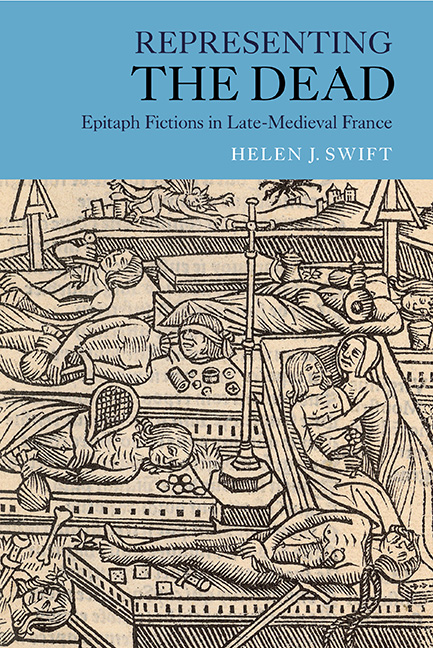Book contents
- Frontmatter
- Dedication
- Contents
- List of Illustrations
- Acknowledgements
- Note on Quotations
- List of Abbreviations
- Chronology of Epitaph Fictions
- Introduction: Representing the Dead
- 1 Framing Identity: ‘je suis’ and ‘cy gist’
- 2 Identity and/as Echo: the ‘Belle Dame’ querelle and Le Jardin de plaisance
- 3 Dying to be told: storytelling and exemplarity ‘selon le stile Jehan Bocace’
- 4 Placing the Dead: Cemeteries, Hospitals and Temples
- Afterword: Illustrating the dead
- Coda: Re-Member Me
- Appendix: Early Editions of the Jardin de plaisance et fleur de rethorique
- Bibliography
- Index
- Already Published
Introduction: Representing the Dead
Published online by Cambridge University Press: 17 June 2021
- Frontmatter
- Dedication
- Contents
- List of Illustrations
- Acknowledgements
- Note on Quotations
- List of Abbreviations
- Chronology of Epitaph Fictions
- Introduction: Representing the Dead
- 1 Framing Identity: ‘je suis’ and ‘cy gist’
- 2 Identity and/as Echo: the ‘Belle Dame’ querelle and Le Jardin de plaisance
- 3 Dying to be told: storytelling and exemplarity ‘selon le stile Jehan Bocace’
- 4 Placing the Dead: Cemeteries, Hospitals and Temples
- Afterword: Illustrating the dead
- Coda: Re-Member Me
- Appendix: Early Editions of the Jardin de plaisance et fleur de rethorique
- Bibliography
- Index
- Already Published
Summary
In 1501, under the title Les Complaintes et Epitaphes du Roy de la Bazoche, André de La Vigne framed within a dream-vision narrative a set of laments and epitaphs in memory of Pierre of Baugé, who, recently deceased, had held the title of ‘the King of the Basoche’, the head of the guild of legal clerks of the Palais de Justice. In the text, members of that society, represented by a personification (‘la Bazoche’), issue apostrophising invective against death and are themselves apostrophised in an exhortation to collective lament: ‘Plourez, plourez, plaignez, lermes gectez’ (v. 198 [Weep, weep, lament, shed tears]). Following this complaint, personified representatives of the societies of four other cities are seen, the persona tells us, bringing forward ‘les epitaphes que cy après s’ensuyvent’ (v. 462 [the epitaphs which follow hereafter]). Each eleven-verse verse epitaph offers tribute to the late Pierre and presents itself deictically as being inscribed into his tomb:
Sous ceste amère, dure et dolente pierre
Gist nostre Roy basilical, dit Pierre.
(CERB, vv. 463–4: the Bazoche of Toulouse)[Under this bitter, hard and woeful stone lies our King of the Basoche, called Pierre.]
Pierre's identity thus lies homonymically both beneath and in the stone (‘pierre’). Having read all eight epitaphs (each representative offers two), the persona awakes. The way in which the epitaphs function is far more complex than this simple plot summary suggests: they are exploited by de La Vigne as a potent textual tool for reflecting on the literary composition of identity and on processes of commemoration. The vital role of the reader in all of this is evoked by the Basoche of Bordeaux:
Pour les passans du long cest ambulacre
Est et sera pourtraict le simulacre
Du noble Roy, que Mort nous veult oster
Vif en vertus, plus hault volant qu’un sacré. (CERB, vv. 474–7)
[For those who pass along this ambulatory, there is and will be portrayed the effigy of the noble King, whom Death wanted to take from us shining [lit. alive] in virtues, more elevated than a saint.]
The ‘passans’ designate, on one level, the physical passers-by, like the persona, who activate the text of an epitaph through their reading of it in the here and now of their present moment of viewing, and who would see, in a funerary monument setting, the effigy of the deceased adorning his tomb.
- Type
- Chapter
- Information
- Representing the DeadEpitaph Fictions in Late-Medieval France, pp. 1 - 36Publisher: Boydell & BrewerPrint publication year: 2016



